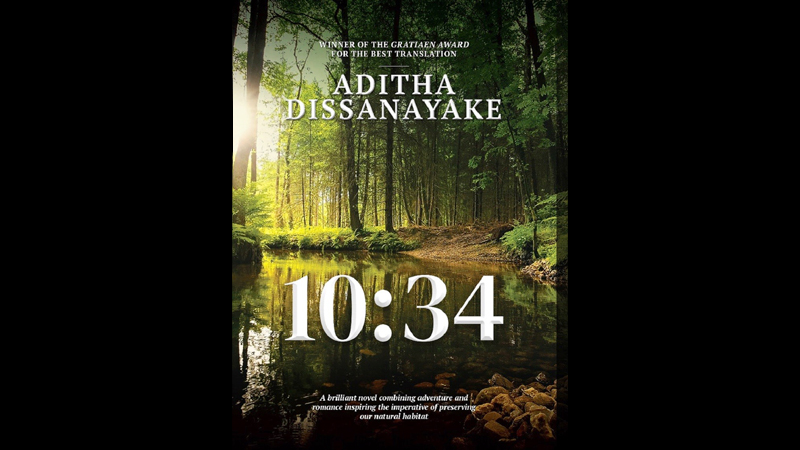Title: 10.34
Author: Aditha Dassanayake
Publisher: Vijitha Yapa
What an awesome novel is Aditha Dissanayake’s newest creativity titled 10.34. It’s her best so far in my opinion. It’s a cherishing trove of creativity, cream of beauty for nature lovers, knotted imposing a dramatic thread into its structure. In short, I would clamour it to be a dish of literary source for the Booker Price Judges. I have read many Booker Price novels. Aditha Dissanayake’s 10.34 reveals the standard its Board requires I surmise.
Thematically it is a revelation of love. Not one of those that sentimentalizes, but one demandingly spiritual. It comes to light only at the very end of its structural composition though underneath it signifies confrontations at the beginning and in the meantime having turns and twists taking place.
Kumi is the running character throughout the story. She is from Colombo, and now she has come to one of the most remote areas in the country – Kothmale, to her grand uncle’s residence amassed by the grown-up gush of trees, plants of clove and coffee, and bushes of various types with a “gurgling stream” inside extending to twenty acres named as Katuvita property with an abandoned, but the nature of a haunted house. She has come to take photographs of the premises which is a broad domain of her uncle who is gone to Australia, to live, but for his use for publicity for the sale of the property. She is engaged to a cousin, Nadush who is busying himself to go to New Zealand which she ultimately breaks for the nature of the existing implicit relationship qualities between the two.
Character development
The property is a subject for a botanist, Dr Kavana Wadugodapitiya, who has entered for research trespassing assuming it an abandoned site. In the meantime, Kumi enters the property, through its detaining entrance that had been created by Kavana. It’s unfortunate when she creeps through it by accident she is caught by her hair knot to the wire mesh. She is unable to get herself released from it. She allows it to get tied to the broken fence which indicates to Kavana that someone had entered and gets worried. Kumi discovers Kavana a trespasser. She manages to send him away ordering, claiming that it’s her uncle’s property. Nevertheless, subsequently, she allows him to carry on his research understanding what sort of person he is. Element of sympathy and humanity emboldens her decision.
The development of Kavana’s behaviour and character dramatically is mysterious and intriguing. This I find a superb mechanism of Aditha’s inherent talents she is possessed with. This is so with other characters too, Kumi, Nadush, Vinoo with whom Kumi confronts the first day she meets him as she experienced with Kavana as well; and no more living souls, Martha and her grandfather, including the minor ones as well, especially, Shantha, Karthi, Maggi Akka, Samarasekera, and the dog, namely Tilly, throughout her novel. The manner Aditha does this is highly restrained, humanely appealing and convincing.
The mode Aditha does this is a qualitative unique feature as is revealed whilst reading in her novel, which I very much appreciate and praise.
Enthralling ideas
The most fantastic element of the novel is the disposition of the portrayal of the natural habitats of flora and fauna with various echoes and whistles of birds surrounding the erstwhile massive and wide building that situates in the acreage which seems deeply occupied after the arrival of Kumi. She now imagines this property to be converted feasibly as a Holiday Resort which Vinno too as a friend, has prompted proposing and approving the idea enthralled with the so beautiful encircling eco-friendly forestry. She finally proposes this project to her uncle too.
Kumi is also very adventurous, which Aditha dispels through the specific character. This component she divulges through the novel, exceptionally in the earlier parts of the novel.
She is artistically also a social commentator. This is quite evident from pages 57- 58 when Kumi had to alight from a bus in the area by the orders she receives from the bus conductor and the driver without considering the safeness of the passenger, and the specific point she had to alight. It prompts the discourteous nature of the transport personnel and how harsh they are. On the other hand, I also find how humanely she treats the passengers travelling in a train offering her seat to a standing female passenger with a child, and the conversation that takes place between both of them.
Finally, I wish to state that Aditha Dissanayake’s novel 10.34 is absorbing and readable. In no time I am sure it will reach the status of a modern classic classification for its novelty of the restrained structural construction and its brilliant theme interlaced with humanity and compassion, and presented dramatically knotted with dynamism.
Reviewed by Dr Namel Weeramuni


